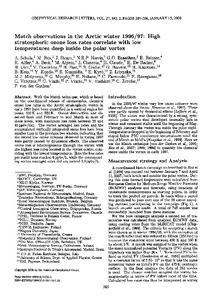Por favor, use este identificador para citar o enlazar este ítem:
http://hdl.handle.net/20.500.11765/11664
Match observations in the Arctic winter 1996/97: High stratospheric ozone loss rates correlate with low temperatures deep inside the polar vortex
| Título : | Match observations in the Arctic winter 1996/97: High stratospheric ozone loss rates correlate with low temperatures deep inside the polar vortex |
| Autor : | Schultz, Martin G.; Rex, Markus; Steger, J.; Harris, Neil R. P.; Braathen, Geir; Reimer, E.; Alfier, R.; Beck, A.; Alpers, Matthias; Cisneros Sanchiz, Juan María |
| Palabras clave : | Stratospheric ozone; Low temperatures; Polar vortex |
| Fecha de publicación : | 2000 |
| Editor: | American Geophysical Union |
| Citación : | Geophysical Research Letters. 2000, 27(2), p. 205-208 |
| Versión del editor: | https:/dx./doi.org/10.1029/1999GL010811 |
| Resumen : | With the Match technique, which is based on the coordinated release of ozonesondes, chemical ozone loss rates in the Arctic stratospheric vortex in early 1997 have been quantified in a vertical region between 400 K and 550 K. Ozone destruction was observed from mid February to mid March in most of these levels, with maximum loss rates between 25 and 45ppbv/day. The vortex averaged loss rates and the accumulated vertically integrated ozone loss have been smaller than in the previous two winters, indicating that the record low ozone columns observed in spring 1997 were partly caused by dynamical effects. The observed ozone loss is inhomogeneous through the vortex with the highest loss rates located in the vortex centre, coinciding with the lowest temperatures. Here the loss rates per sunlit hour reached 6 ppbv/h, while the corresponding vortex averaged rates did not exceed 3.9 ppbv/h. |
| Patrocinador: | This work was supported by the Environment and Climate Programme of the Directorate General for Science and Technology (DG-XII) of the European Commission (contract no. ENV4-CT95-0145), the Bundesministeriumff ir Bildung, Wissenschaft, Forschungu nd Technologie(B MBF) of Germany( contract no. 01 LO9508/6) and by all the countrieso f the participating personnel. AWI contribution number: 1549. |
| URI : | http://hdl.handle.net/20.500.11765/11664 |
| ISSN : | 0094-8276 1944-8007 |
| Colecciones: | Artículos científicos 2000-2004 |
Ficheros en este ítem:
| Fichero | Descripción | Tamaño | Formato | ||
|---|---|---|---|---|---|
| 1999GL010811.pdf | 603,21 kB | Adobe PDF |  Visualizar/Abrir |
Los ítems de Arcimis están protegidos por una Licencia Creative Commons, salvo que se indique lo contrario.





